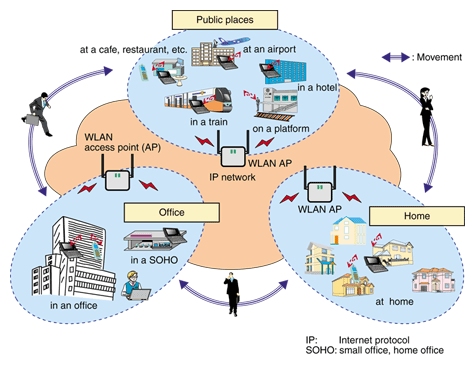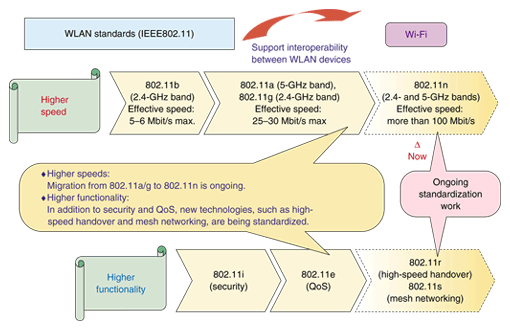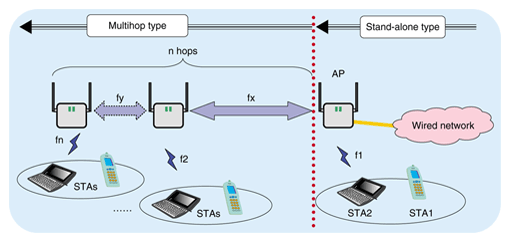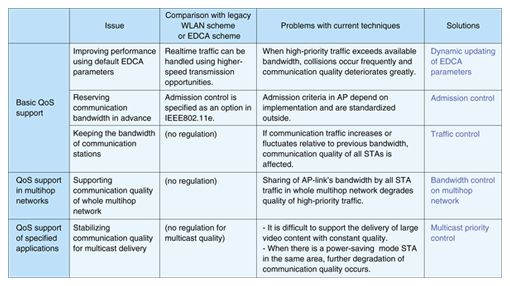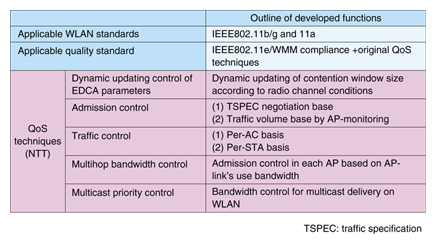 |
|||||||||||||||
|
|
|||||||||||||||
Vol. 5, No. 11, pp. 33–38, Nov. 2007. https://doi.org/10.53829/ntr200711sf5 Overview of QoS Control Techniques for Wireless Local Area NetworksAbstractIn response to the growing need to support multimedia applications on wireless local area networks (WLANs), we have developed quality-of-service (QoS) control techniques to achieve higher and more stable communication quality than that of legacy WLAN services. This article presents an overview of our QoS control techniques for WLAN communication, which are based on the IEEE802.11e EDCA (enhanced distributed channel access) standard, and introduces the main functions of the software we developed. It also acts as an introduction to the other articles in this Special Feature.
1. IntroductionWireless local area network (WLAN) services are now used everywhere, especially in homes and offices but also in many public places and even outdoors. Accessing wireless broadband services with a personal computer (PC) through a public WLAN service is also increasingly popular. An illustration of WLAN services is shown in Fig. 1. With a terminal such as a PC, the Internet can be accessed through a WLAN from public places, offices, and homes. In best-effort type communication, such as Web access, communication on legacy WLANs was no problem. However, to support future multimedia communications (e.g., video and voice) on WLANs, it is necessary to make the communication quality more stable. Therefore, we have developed quality-of-service (QoS) control techniques for WLAN communication that we intend to apply to public WLAN services. These techniques are based on the IEEE802.11e EDCA (enhanced distributed channel access) scheme [1]. After reviewing WLAN technologies, we describe the problems with communication quality on legacy WLANs. Then, we explain the techniques we have developed for QoS control and introduce the functional software used to implement QoS control for WLANs.
2. General trend in WLAN technologies2.1 StandardsAn overview of the standards related to a typical WLAN is given in Fig. 2. The IEEE802.11 standards that apply to WLANs are 802.11b/g and 802.11a. Although the maximum wireless transmission speed for 802.11g/a is 54 Mbit/s, there have been standardization efforts aimed at higher access speeds, namely IEEE802.11n, which specifies a maximum throughput of more 100 Mbit/s. Moreover, in comparison with the conventional WLAN standard based on best-effort communication, quality control is now defined by the 802.11e standard as a subset of the 802.11MAC layers (MAC: medium access control). Work is also being done on 802.11r and 802.11s, which regulate high-speed handover and mesh networking, respectively. The work done on standard 802.11 has increased WLAN functionality.
To ensure the interoperability of WLAN devices, such as access points (APs) and WLAN terminals (stations (STAs)), attestation tests in the Wi-Fi alliance are carried out in accordance with IEEE802.11 standards. For example, the interoperability test for 802.11e-EDCA is called Wi-Fi Multimedia (WMM). It ensures that it is possible to execute a priority control communication on a WLAN between any WLAN devices that conform to the WMM standard, even if the devices are from different manufacturers. 2.2 Frequency band assignmentsIEEE-802.11b/g WLANs use the 2.4-GHz frequency band, and IEEE-802.11a WLANs use the 5-GHz band. The 2.4-GHz band can be used freely as an ISM (industrial, scientific, and medical) frequency band. However, various types of wireless equipment, such as microwave ovens, medical equipment, and Bluetooth devices, also use those frequencies. In contrast, the 5-GHz band is freer from interference than the 2.4-GHz ISM band, but to avoid causing interference with radar, it is limited to indoor use (5.2-GHz band (5.150–5.250 GHz) and 5.3-GHz band (5.250–5.350 GHz)). Use of the 5.6-GHz frequency band (5.470–5.725 GHz) both indoors and outdoors was approved in January 2007 and regulated use began in April 2007. WLANs using this frequency band will also be used outdoors from now on. Additionally, in the 5.3- and 5.6-GHz bands, the WLAN devices are specified to support dynamic frequency selection (DFS), a capability that helps WLANs avoid radar interference, and to support transmitter power control (TPC) depending on the transmission power. The frequency assignments for WLANs are illustrated inFig. 3.
2.3 IEEE802.11e EDCAThe 802.11e EDCA scheme is a priority control function with extended 802.11MAC layers and has four access categories (ACs). Two of the ACs support multimedia applications, such as voice and video, and the other two support the conventional best-effort applications. In the case of a network composed of a wireless LAN and a wired network, for example, by mapping eight user priorities of the wired network onto four ACs on the WLAN, one can achieve priority control based on the type of user throughout the network. The 802.11e EDCA standard is explained in detail in the next article in this Special Feature: “Technique for Dynamically Updating EDCA Access Parameters for WLANs” [2]. 3. Problems in WLANsThere is a basic problem with the communication quality of WLANs, which does not affect wired networks. Unlike wired communication, communication using radio waves suffers significant degradation due to external factors, and the transmission of wireless communication is subject to fluctuations. Because a 2.4-GHz-band WLAN (IEEE 802.11 b/g) shares the ISM band with other equipment, there is significant interference, so the radio bandwidth available for the WLAN is decreased. Moreover, in WLANs, the probability of retransmission to correct a frame error is higher than in wired networks, so the WLAN scheme uses adaptation modulation. Therefore, a WLAN has a radio bandwidth (radio occupancy time) that changes dynamically according to radio conditions. WLANs also use carrier sense multiple access with collision avoidance (CSMA/CA), which is a scheme that has autonomous and distributed control at each wireless terminal. Consequently, communication quality control is more difficult in the case of a WLAN than a network with centralized control provided by an AP. In general, there are two types of WLAN network configuration: stand-alone and multihop, as shown in Fig. 4. In stand-alone WLANs, the AP connected to wired networks communicates with an STA controlled by the AP. To stabilize the communication quality (delay and packet loss) of an STA connected to the WLAN, it is necessary to control the quality at the AP so that the maximum bandwidth of the particular type of WLAN is not exceeded. To improve communication quality, it is necessary to solve the following problems of conventional WLANs. When the general parameters in the EDCA standard are applied, collisions of high-priority traffic significantly degrade the communication quality of all STAs using EDCA. Moreover, although admission control is defined in the 802.11e EDCA standard, it is an optional standard and the judgment of admission criteria at the AP depends on the implementation. Therefore, a detailed implementation is needed to stabilize communication quality using the connection restriction function of the traffic over the radio bandwidth. Furthermore, the communication quality of other STAs may be degraded by traffic that exceeds the bandwidth of any STA that has been admitted.
In multihop WLANs, the connections between APs are wireless connections. Since multihop WLANs can connect to STAs in places that are not in a wired network, i.e., where there are no wired connections, they can be easily extended. However, the communication quality of an STA connected by multihop APs is more easily degraded than that of a stand-alone AP by the traffic in the intervening AP links. Furthermore, although multicast applications, such as video streaming delivery, are used more often in wired networks, it is difficult to stabilize their communication quality in legacy WLANs. This increases the need for techniques that can support multicast application delivery on WLANs. 4. QoS control techniques and softwareTo solve the WLAN problems discussed above, we have taken on the challenge of developing higher communication quality on WLANs. The problems in conventional WLANs and their solutions are summarized in Table 1. We developed software to implement the solutions. The main functions of the developed software are listed in Table 2. A basic feature of the software is the function for managing communication quality of STAs at APs. If an STA device is based on the IEEE802.11e EDCA/WMM standard, the AP can support the functions listed in Table 2. Standards 802.11b/g and 802.11a are supported as the physical layer, and new NTT-developed techniques were added to supplement the IEEE802.11e EDCA/WMM standard, which covers MAC-expanded functions. These additional techniques can improve and stabilize the communication quality on a WLAN. Applying them at an AP can improve WLAN communication beyond what is possible with a legacy WLAN. These techniques are described in detail in the other articles in this Special Feature which cover: a technique for dynamically updating EDCA access parameters for WLANs [2], admission and traffic control techniques for WLANs [3], an admission control scheme for resources shared by APs in multihop WLANs [4], and priority control techniques suitable for multicast delivery on WLANs [5].
5. ConclusionTechniques developed to control the communication quality of WLANs were introduced. They enable access points to support multimedia applications such as voice, video, and other multicast content. In the future, these techniques are expected to become important in WLAN communications. References
|
|||||||||||||||








